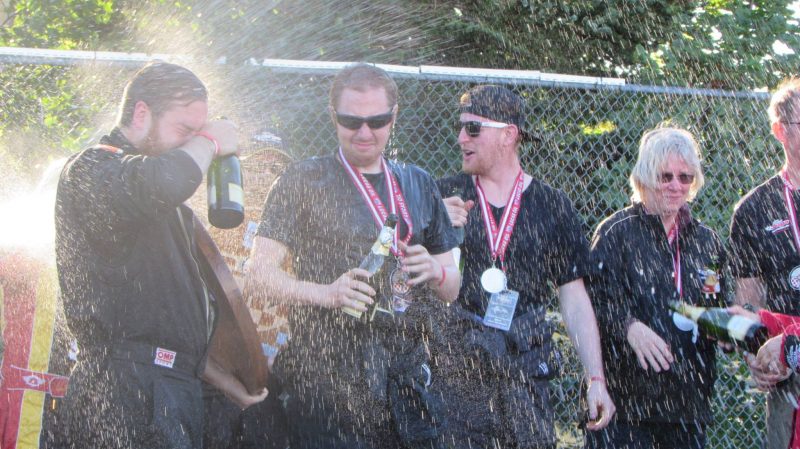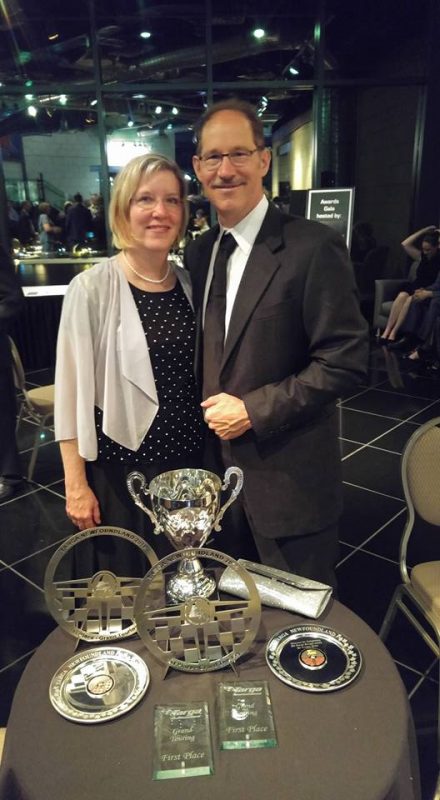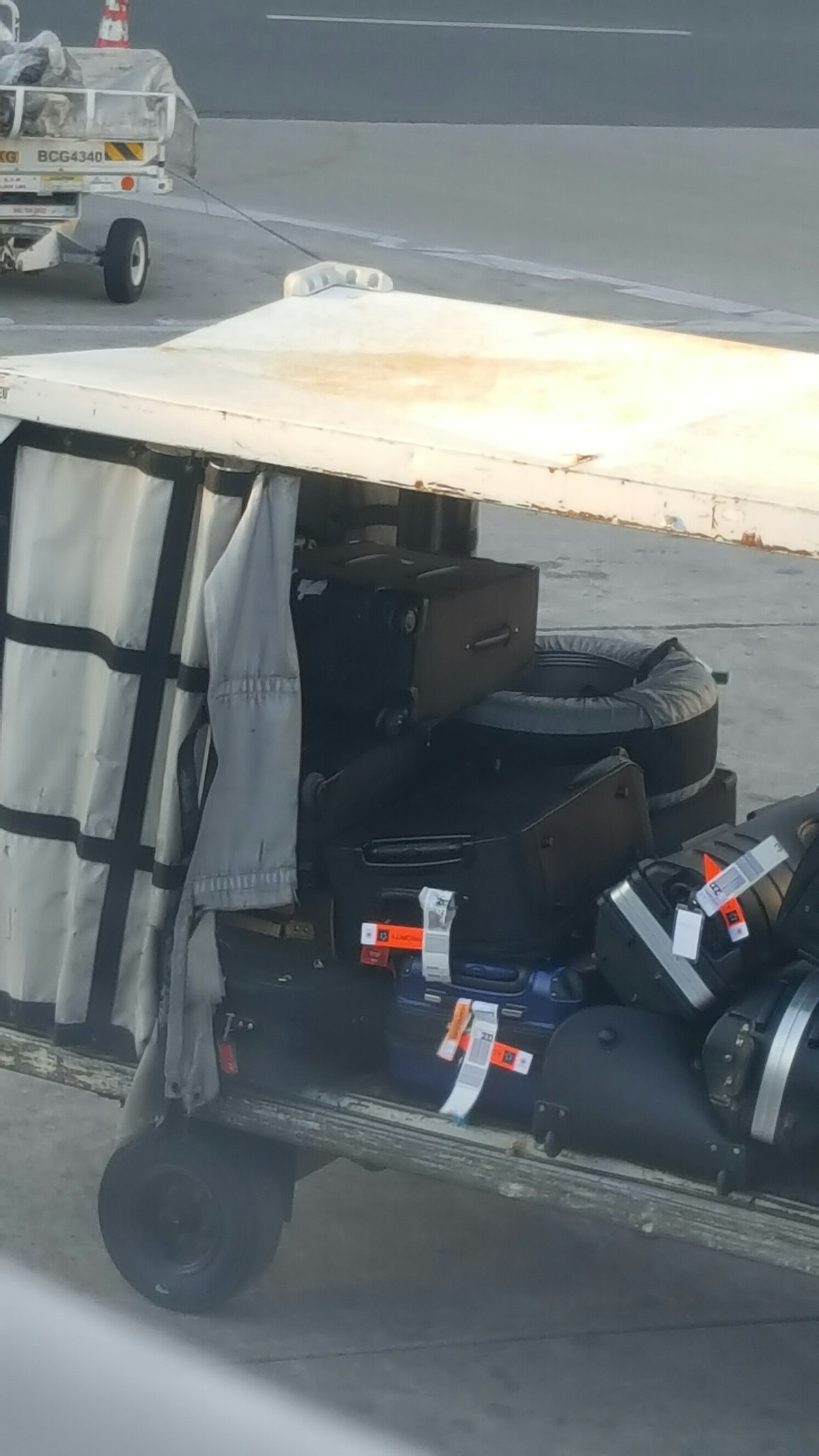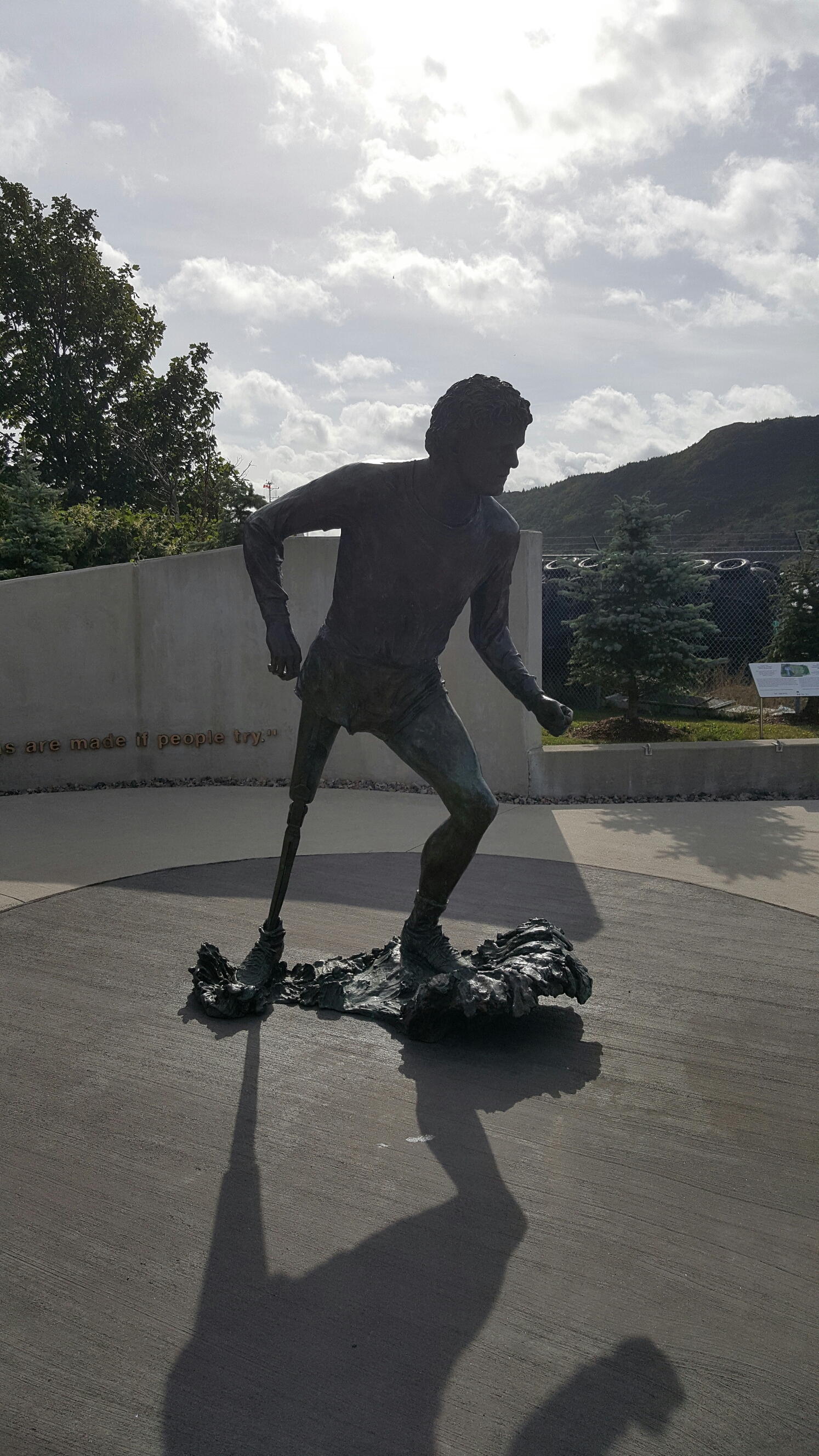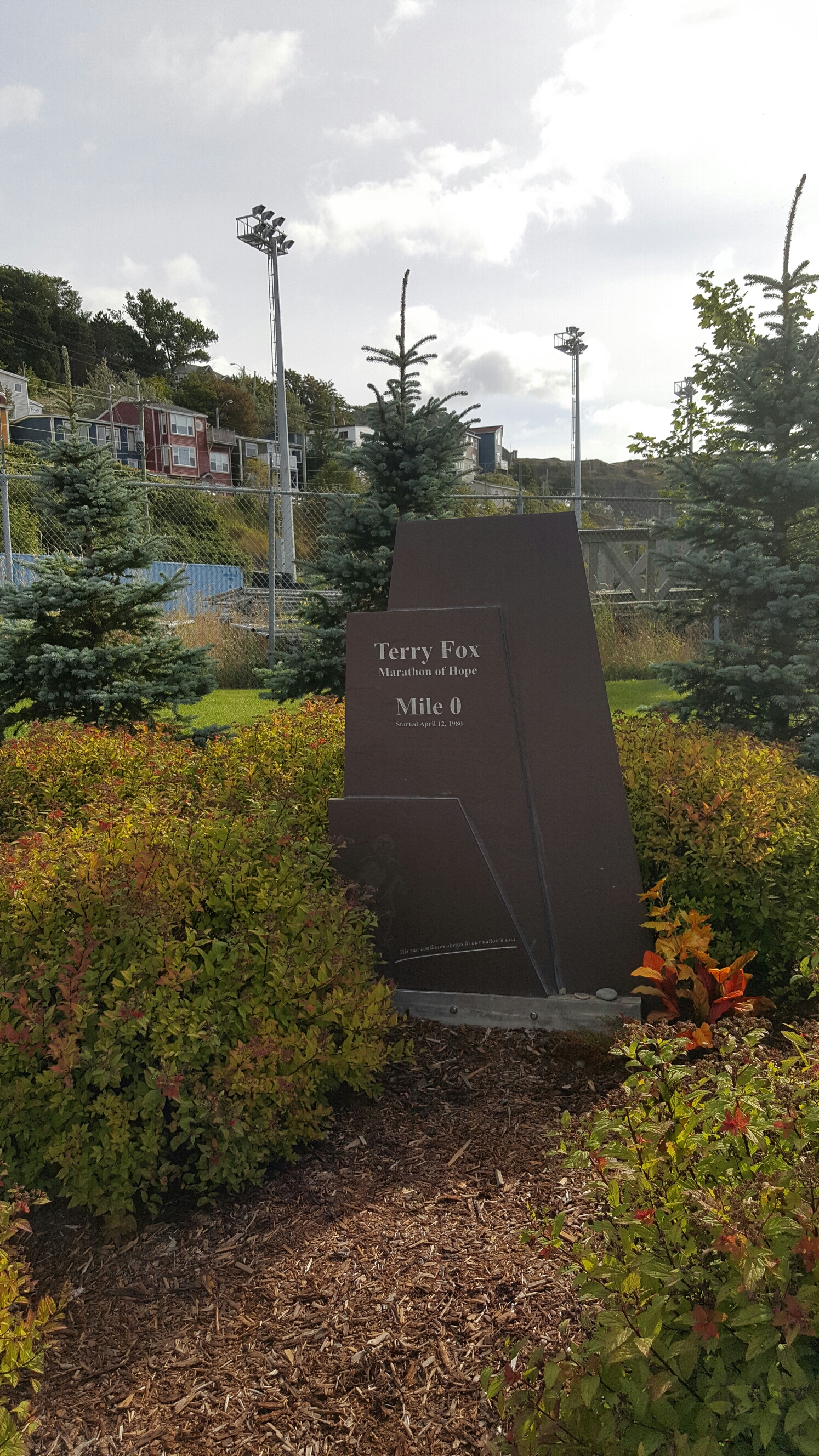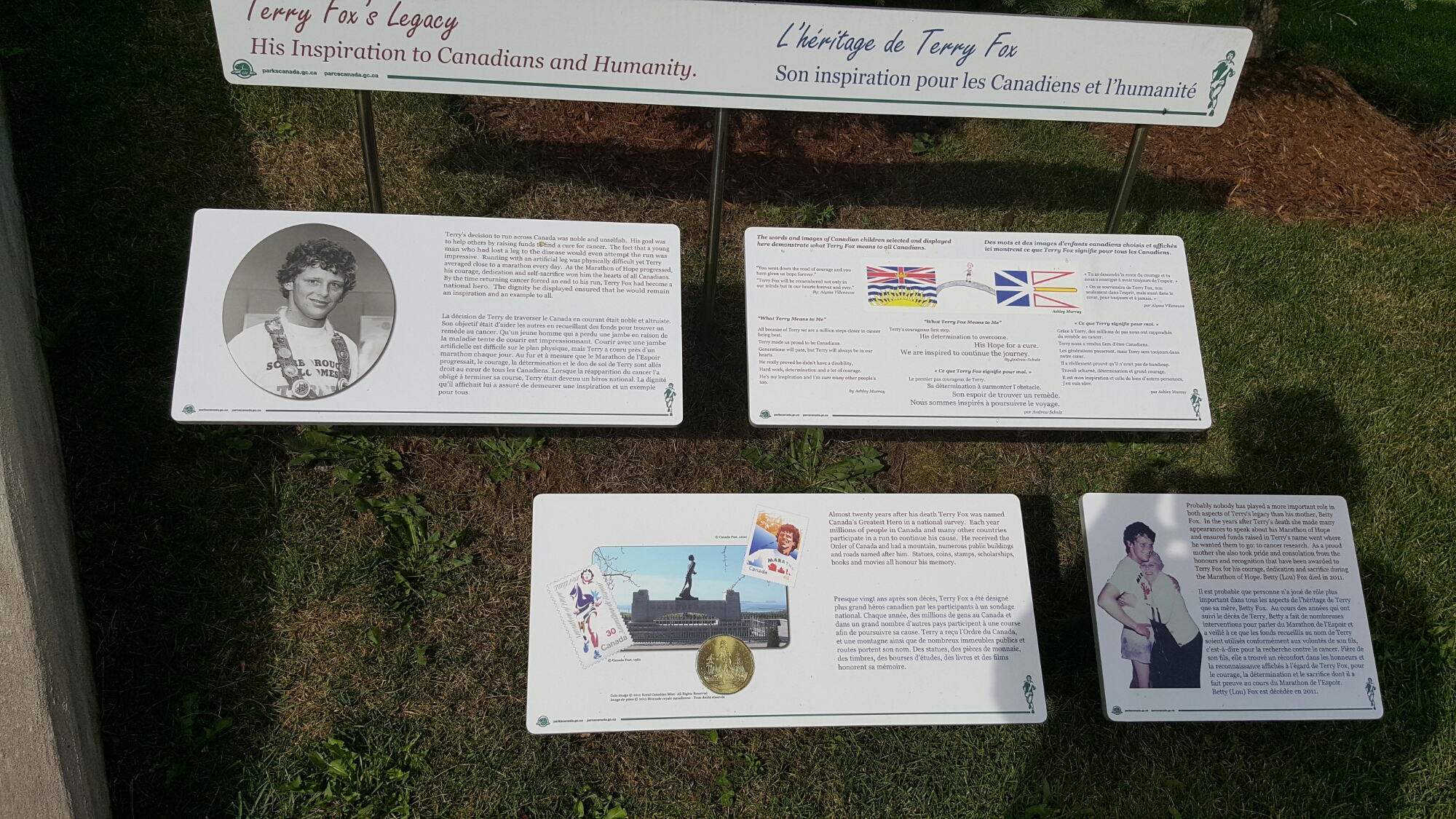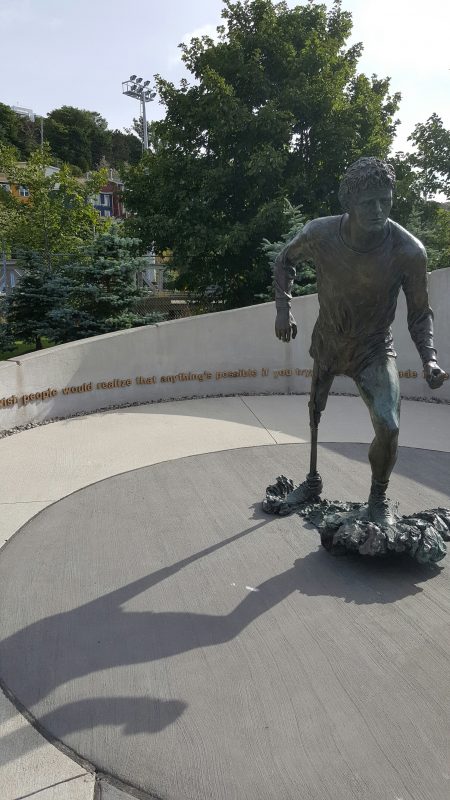Targa Newfoundland 2016
This rally* started, for us, eighteen months ago. That’s when the illustrious Frank McKinnon roped us into his scheme to run Targa “while it’s still around”.
Now Frank’s done a lot of rallies – from AlCan to the modern Carrera Panamerica – and even more racing. He’s also helped organize big motorsports events, having run tech for the Silver State Classic in recent years. Frank’s the most “in the loop” racing guy I know. So when Frank said, “This is the year to go to Newfoundland – John and I are entered, so we can help each other out there”, we heard the knock of opportunity and answered the door.
We’re not Targa racers, though – we’re time-speed-distance ralliers. Our cars don’t have roll cages; instead, they have high-precision odometers and lots of clocks. Good thing, then, that Targa Newfoundland includes a time-speed-distance division, called ‘Grand Touring’ (or just GT). We signed up for the 2015 event, and started working on the logistics of getting to, and competing on, Newfoundland.
That visit was a roller-coaster of dashed hopes, tiny satisfactions, thwarted efforts, wild hopes, and ultimately a narrowly-won victory for us. Part of the problem was that we brought the wrong car, a station wagon, and part of the problem was that we brought the wrong habits.
It was an all-wheel-drive wagon, with powerful brakes and stable handling – but it just didn’t have the giddiup we needed. Time-speed-distance events in the Pacific Northwest run on open roads, which keeps the speeds down. Targa runs on closed roads, and the speeds are brisk. Hell, they’re more than brisk, even for the GT class. In 2015, I spent more time with the gas pedal pressed flat to the floor than not.
Our habits, also tuned to PNW-style events, emphasize being ‘on time, all the time’. You daren’t run too far ahead of perfect time lest some unseen control charge you points for your early arrival. But Targa’s different; the sections have very few intermediate controls, and their finish lines are frequently set after a series of twisty, often blind, often wet, curves. If you are on-time at the start of that series, then you’ll be late into the finish. Targa Newfoundland must be run like a Monte Carlo style rally, and we didn’t figure that out ‘til mid-week last year.
The overall Targa experience so stunned us – especially the final result – that we put ourselves on the entry list for 2016. We were seeking clarity, and closure, and a kind of proof that we earned the 2015 win, and didn’t just stumble into it when others faltered. So we were in St. John’s this year as a direct result of Frank’s call to action last Spring.
And this time, we brought a Porsche.
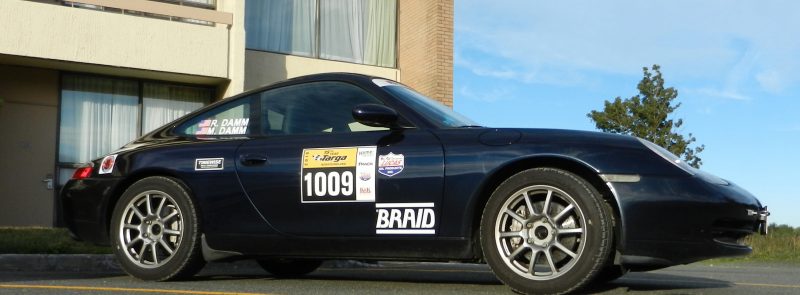
* a ‘rally’, generally, is a motoring competition carried out on roads (either closed or open) versus occuring on a track or course. The essence of rally is variation and surprise, versus perfecting a lap around a racetrack.
Getting There – And Back Again
Targa’s a full week of competition, but first you’ve got to reach the province. Since our car lives in Portland, Oregon, getting the car to the ferry dock in Nova Scotia takes another six days, minimum. And the ferry ride is 14 hours more… The trip home’s a hard seven days.
Our time-off-work allotments were already strained, and we couldna’ afford to make two cross-country road trips in a single month. It was easy, though, to find a couple willing to drive the Carrera 4, expenses paid, across the United States. We also found a volunteer to drive it back – all the way from Cape Spear, the easternmost point in North America – in the first person we asked.
Aside from car preparation, which occupied every free weekend in June and July, our part in this play started when we flew to Boston, and met the couple who’d driven east. They were perfectly on time, the handoff was seamless, and we ran the 996 up to Portland, Maine, the same evening. Then things took an unexpected turn. First, ZZ Top was playing on the pier, and Portland was packed with people. The pubs’d run out of cod, so no Fish-n-Chips to be found. More disturbing, the ferry we’d booked from Maine to Nova Scotia for the next day was cancelled – for high swells – and we’d have to drive ‘round through New Brunswick instead.
The cancellation was inconvenient, but not a real threat to our schedule. In the maritimes you’re always at the mercy of the weather, and we’d built in extra time. Still, as we cruised up the Bay Of Fundy on Labor Day, we heard rumblings about the ‘tail of the hurracaine’ that’d raised the swell, and began to worry. What if our second ferry, two days hence, from Nova Scotia to Newfoundland, would likewise trapped at the dock by heavy seas?
So we ran like chickens for the ferry dock, hoping to catch an earlier run while the waves allowed the passage. That we did, though we had to take the shorter cruise to Newfoundland, which leaves you on the sou’west edge of The Rock. Next day, we faced a 900km drive to St. John’s.
By the way – when you’re on the Trans-Canada Highway (TCH) from Port-aux-Basque, and you see a sign that says the town ahead is 220km away, you’ll think, “Okay, I’m going 110kph, so it’s two hours away”. Not when there are 6km long ‘construction zones’, posted at 50kph, every 30km. I don’t begrudge the Newfies doing road improvements during the short summer, but I think the construction zones might have started and stopped a bit closer to the bridges.
How’s It Going?
Soon after we left Boston, I noticed that the Porsche’s steering wheel was vibrating on the highway. The car has a lot of road feel – it’s one of its strengths – but this I was something else. The vibes lessened at lower speed and on smoother roads, but it felt wrong. I tried to reason out the cause while driving headlong to the east. The wheels were unmarked, and the tires near new. I was afraid it was a failing wheel bearing; I even started thinking about how to change it on the island… since there’s no Porsche dealer, the parts’d have to come from elsewhere, …call Porsche dealer in the US, get ‘em ordered, have our service guy pick them up before he flew out to meet us, AND figure out how to do the work on the only possible day, a Saturday, without a shop…. Brrrr, still makes me shudder.
I did not mention my fears to the co-driver ’cause she’d worry.
As it turned out, the vibration was just wheels out of balance. The fronts were each off by more than an ounce. Onward!
Saturday – Tech
Targa’s organizers arranged for a beautiful facility this year. The building had copious parking and 4 spacious work bays. The inspection process was tremendously more orderly than 2015, and all the cars were cleared by 4 p.m. We were done in the morning, even, and had time to install the special Lucas oil.
Well, the oil itself was just good 0w-40 synthetic. What made it special was that Lucas gave us a dozen liters since we’d entered the Lucas Oil Challenge (more on that later). Our support guy, Larry, and I took the oil, a filter, a copper washer, and a filter wrench to a local service station to get it in the engine. The service station wouldn’t let me use the lift; the best concession I got was to stand nearby while the ‘Technician’ did the work.
It was going reasonably well, even when the tech used a Torx bit on the drain plug (which calls for an Allen bit).  But then there was the problem with the counting. The M96 motor holds 8.75 liters with a filter change, and the tech dutifully poured bottle after bottle in, stopping short on the last one. He returned two full bottles and the partial one, and was getting ready to take the car off the lift. But the math wasn’t working out…
But then there was the problem with the counting. The M96 motor holds 8.75 liters with a filter change, and the tech dutifully poured bottle after bottle in, stopping short on the last one. He returned two full bottles and the partial one, and was getting ready to take the car off the lift. But the math wasn’t working out…
Yes, he’d overfilled the engine by a quart: it wanted 8.75l, he put in 9.75l. l pointed out that only 2-point-something quarts were left from the twelve, and he reached the same conclusion after a minute. Then … he ‘removed’ the excess oil by pulling the drain plug, spilling the fresh oil into the catch-pan, ‘til he guessed that a liter’d come out. This quicker than we could stop him.
Support guy Larry was incredulous; I was just looking for the quickest way to escape with the car. I double-checked the drainplug torque, paid the bill, and we skedaddled. So, yeech. But the oil was in the engine.
In a questionable move, the Targa organizers didn’t release the GT Class Target Times & Speeds books before the event. Those books were only handed out at registration. The result was that the GT class navigators had no free evenings for the majority of the event; they spend each night doing time calculations for the upcoming days.
Sunday – Prologue
The delayed delivery of the Target Times and Speeds book kept my co-driver up late Saturday night doing the math. At registration, we’d also been handed a page of routebook corrections, including changes both within stages and to the order of stages. Such corrections need to be entered in the routebook, but some novice crews didn’t realize their importance. “Just one more piece of paper…”, I suspect.
On Prologue Day, the GT class runs in car-number order. That sorted us behind two other cars with lower numbers, both of which at least had previous Targa Newfoundland experience. Having those trailblazers eased our nervousness. Getting into the Targa rhythm takes a while – and not only for us; the stage & timing crews are working out the kinks, too.
Pretty quickly we realized that, like last year, the clock synchronization was spotty. For Targa cars, it’s no big deal if successive stages’ clocks aren’t on the same beat. In the Targa classes, each stage’s time stands alone: there are no ‘road points’ between stages, nor scheduled service check-in times, nor ATCs. So each stage only requires that its Start and Finish clocks agree.
In GT class, however, each stage might have extra timing controls, mid-stage. GT cars take penalty points if they’re off-time at those mid-course controls. So for us, all the clocks – start, finish, and the intermediate controls’ clocks – need to be synchronized. There there’s some evidence that they’re not all syncronized, and it’s the intermediate controls that most worried us, because there’s no way for us, passing at speed, to know what time is on that clock.
But time, you know, is not first priority in TSD. Good performance in time-speed-distance rally comes from following three rules:
#1 Stay on the road.
If you slide into a ditch or nose into a tree, you may not even finish.
#2 Stay on the route.
A missed turn will force you to back-track, and you lose time both ways. With competition tight, a single deviation can keep you off the podium.
#3 Stay on time.
Once you’ve taken care of #1 and #2, the real work begins. You have to match the official mileage, AND you have to calculate as the rallymaster did. Getting mileage right requires precise measuring devices and keen attention to their fidelity. Your rally odometer must be adjustable, both for initial calibration as well as for on-stage corrections. If the route was measured on a wet day at 30kph, and you’re running on a dry day at 90kph, you’ll notice.
Our odometer calibration wasn’t bad, but we weren’t the most precise team on prologue day. By the end of the day, we were barely in the top half of the field. A couple of other cars were briefly off course on Sunday, not having made the corrections to the routebook.
Monday – Leg 1
Our pitiful precision in the prologue had us 5th car on the road.
We were directly behind a fully-original 1981 MGB. Do you know what motivates an ‘81 MGB? About 80 horsepower when it was new. We thought we’d catch the MG during a stage, and we did – but not until the last, long section of the day. In the short sections, the doctor (a G.P.) who was driving kept the little roadster well out of sight.
Leg 1 started on the same stage as last year, two runs through a short, narrow, country lane-and-a-half, dropping down to run along a harbor wall, rising around a church, and finishing with a chicane assembled from a triangle of bridges. Short, tight, concrete bridges. Last year, a wicked pothole in the chicane took out one of the favored Targa cars on the first run-through. Bam! Broken ball joint in the first hour of a week-long competition. No such bad luck this year, everyone made it through cleanly.
Renee and I were taking advantage of the 12-second timing window on Monday morning, trying to run a bunch ahead. Keenly watching for Intermediate Timing Controls, we were hashing out our in-car communications. How should the corners be called, When, What ack should be given, How do we handle emergencies, the lot. Targa generates different in-car messages than any other rally we do.
Next two stages were an in-and-out pair; the out, Turk’s Gut, was also the scene of first-day retirements last year. In this context, ‘retirement’ means “crashed so hard the cars didn’t come back ‘til Thursday”. I feared someone might crash this year, because the same dreadful off-camber jog over crest was in the stage, and excitement was building in all the cars as we got a taste of the rally. Happily, all cars came through to lunch at Brigus Town Hall.
In the early p.m., more short-ish stages. Speeds were pretty high, considering we were driving through neighborhoods, but it being Monday, not as high as they’d be later in the week. The rally was running a bit behind as we got to the final pair of stages in Leg 1. This was another mirror set, where all the cars run “in” to a turnaround point – often at the water’s edge – and then regroup for a reverse run “out”. Last year, these were the stages that showed us the pace required for Targa. In 2015, in a driving rain, we ran late into the finish of both.
This year, we brought more power, more brakes, more handling, and (I hope) more skill.
When the road’s yours alone, from shoulder to shoulder, and the next curve’s still some tenths away, the pipes wail tremalo and the digits roll up on the speedo. You know the pads and rotors and fluid are fresh, the middle pedal’s got your back, there when you need it. Brake early because you should, slow in and fast out, open asphalt again and nail it…
Huh; caught up already. Okay, run just a little up – and that’s how we finished the ‘in’ run.
At the turnaround, waiting, we were baffled by the appearance of the Fast Tour Lamborghini before all the GT cars are in. If anybody’d gone off, we’d have heard about it, and we hadn’t. But… then how could the following class already be finishing?
Well, Lamborghini. And Fast Tour has no ‘early penalty’ – they do have a $$ penalty for exceeding the class’s MaxSpeed, but that might not dissuade some folks. If you’re in a Lambo and your Support Car is a Ferrari, $$ probably seems like ₵₵. The pilot passed everyone in front of him in Fast Tour, and then started passing the GT cars.
The MGB’s navigator is another doctor, a gastroenteroligist. His eyes are a bit wide, reflecting the torrid pace required to make the end-time. Then he released a confessional stream of self-diagnosis regarding sphincter control and et., reducing Renee to tears of laughter.
On the outbound leg, the sun’s setting, and a couple of crests are facing a blazing Sol. We caught the MGB on this run, and had to go around ‘em. My first passing attempt corresponded with them cresting a rise into that blinding sunset, and – unaware of our presence – the driver carved toward the left of a coming corner and I had to dive to the edge of the road, on the brakes. The next attempt, once he knew we were there, was clean. And the Porsche again made running on time possible.
Tuesday – Leg 2: The Lambo Passes Everybody
First I have to fix something. Above, I said:
Monday – Leg 1
Our pitiful precision in the prologue had us 5th car on the road.
But the Keeper Of The Records has corrected me. Here’s what actually happened: On the first Prologue run, through the ‘Flatrock’ stage, there was a scoring error for the finish control.
The first car on the road – first car through the finish control – didn’t get a time for the stage (it was blank). The second car on the road got a time that looked a lot like the time the first car should have had; and we, the third car on the road, got a time that looked a lot like what the second car should have had. Then, behind us on the scoring sheet was an extra-large window of time with no car…
and then the fourth car on the road had a sensible time, and so did the rest of the cars.
One plausible explanation is that the control crew saw the number of the first car on the road (1002), and figured that meant Car 2 on the scoresheet,so skipped the first line. They’d have been confused when the number on the next car was 1007, but they wrote it down on the next line, then they realized it was all wonky, and took a breath to catch up. By the time the fourth car approached, they had a grip and finished the set.
I describe that as ‘plausible’ because I’ve had similar feelings while working controls. 🙂 There’s a lot of pressure, man!
We didn’t see the scores for Prologue ’til the starting order was already set for Monday, so we didn’t have a chance to ‘inquire’ about it. And it being Prologue, not scored, it was an essentially harmless error — except that it sorted us further down the field for Monday, but as you’ve already read, that turned out okay.
We now rejoin our Tuesday tale:
Around 6:45 a.m., we reached the arena and checked the notice board. Results showed us with 37 seconds of error, assigned by an ITC on the fourth stage of the previous day. The ITC scored the first four cars close to their perfect times, then scored each of the following cars at roughly 30 seconds late. Amazing coordination, I thought, all those cars deciding to run half-a-minute off, just past the intermediate control, but catching back up by the end. 🙂 It seemed like a clear pattern, so we prepared an inquiry – only to be told that inquiries had to be in by 7pm of the preceding day.
That was plainly impossible in this case, because the scores hadn’t even been posted ’til 2am. We’d have had to see the future to protest a score that wasn’t even available yet – but the organizers wanted to have rules and stick to them. Our competitor relations officer took the inquiry anyway, after acknowledging the nuttiness of the rule.
That big score (25 after accounting for the 12-second window) kept us sorted down the starting order for this day. In the morning, we passed the MGB on an inbound stage, easy and clean, then convinced ’em to let us precede them on the way out. A trio of new-to-Targa stages in the afternoon had some silly-slow CASTs for GT, boring for us and boring for the spectators; but behind us the Fast Tour and Targa cars put on a better show.
And then longest stage of the week: 26km, Grand Le Pierre Out.
Our CAST for most of it was 105, easy to make on the gently curving road. Our GT guru, Craig, had warned us about a deceptive acute turn coming down into Terranceville, and we were thinking about that when I saw the Lambo coming up. He’d started at least four minutes behind us, but we were stuck at CAST and he … wasn’t. We moved over and away he went, no bother at all. The pilot was polite and careful whenever I saw him, by the way.
But his Fast Tour compatriots had caught on to his methods, and were likewise trying to fly. A new bimmer went by, on a straight outside town, and then we were approaching the deceptive acute.
Almost a hairpin, really, left and uphill with the main road continuing straight but taped off. There were hundreds of spectators there, and a good place to watch: car after car locked the brakes, or slid through the turn, or overshot and had to reverse — that that corner was full of crazed drama.
Our CAST had dropped, and prepared by Craig’s warning we were set up well for the hairpin, taking a wide line, trying to stay close to on-time throughout – when a Dodge Magnum wagon launched off the hill behind us, carrying too much speed, squirmed and lurched its way toward the inner ditch, and bulled its way inside us at the point of the hairpin. Our setup and wide line let us give way, and they managed to get it together and make the corner. 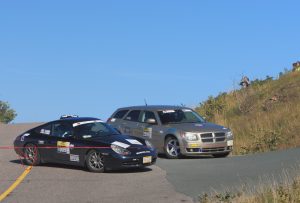 Coulda been bad – plenty of skilled drivers flat missed that turn, and the Magnum could have easily taken us out.
Coulda been bad – plenty of skilled drivers flat missed that turn, and the Magnum could have easily taken us out.
This was a Fast Tour car, mind: they were running ‘for fun’. But we were competing: we needed to hold the CAST. Either they didn’t know or they didn’t care about their disruption. Renee was sharpening her hatchet, because thoughtlessness like that is a serious offense with her.
About .8 km later we reached the Flying Finish and zeroed it. And about 10 seconds after I parked the car the Magnum boys were at her window apologizing for the event. So there was no harm done, in the end, and no blood spilled.
As I said, lots of chaos in that corner. Here the Mini’s trailing red tape from having overshot something.  We wondered about the wisdom of placing Fast Tour behind GT this year. T’was the reverse last year. Maybe it fits with another Targa practice: they line the Targa cars up slow-to-fast (whoever’s got the fewest penalties starts last). This means, if you’re a Targa car, there’s a good chance that a slower car (one which can’t make the target times) is in front of you. So you may catch them on-course.
We wondered about the wisdom of placing Fast Tour behind GT this year. T’was the reverse last year. Maybe it fits with another Targa practice: they line the Targa cars up slow-to-fast (whoever’s got the fewest penalties starts last). This means, if you’re a Targa car, there’s a good chance that a slower car (one which can’t make the target times) is in front of you. So you may catch them on-course.
Wednesday – Leg 3
At the arena in the morning, our penalty from Monday’s been erased, so we’re sitting at zero penalty for the week, tied with a couple teams. Our car number’s lower than the folks we’re tied with, which would normally see us first on the road. But the starting order still has us mid-pack. There’d been several revisions to the standings on the previous evening as scores came in and inquires were accepted, and the registrar didn’t update the start order after the second revision. I guess he’s got to sleep sometime.
We were ahead of the MGB, at least – and we don’t mind running quiet and deep like a barracuda versus first car on the road.
The previous evening, we’d looked up the actual rule on Submissibility of Inquiries, and turns out there are two types of Inquries. A ‘posted scores’ inquiry is allowed on the following day, so our submission was legit. The officials were reading the wrong paragraph on Tuesday when they said it was late. Are you getting the sense that part of the navigator’s job at Targa is double-double checking the scores and fixing any issues? Yesss…
Yeech: big off in the morning. We went through the Leffbridge stage before the Targa folks, naturally, and we noticed a surprising crest/left/right that wasn’t in the routebook. Good Guys Max & Wayne, in a fast Evo, flew off the crest, off the road, and into the perpendicular rocky gulch and culvert.
They were pretty much okay – the navigator came back later in the week in another car – but the incident cancelled the second running of the stage, and a second routebook error (missing instructions) sent us the wrong way on the succeeding transit. We recovered in time for the next series, one of the best in Targa week.
Trouty takes you back and forth over a finger of land, wrapping up around a little bay, and flows right into downtown’s tiny streets and alleys. Service crews are already in town; this is one of the few places they actually get to spectate. The final 20 corners are good for lots of giggles. But you’ve got to hustle – so many tight 90s that making the CAST means WFO throttle anywhere you can. The flat six roars through the houses, tires howl, locked up brakes throw stones on the final straight after the Flying Finish. And when your heart slows down, the weather’s grand, it’s sunny and pleasant in Trinity town.
After lunch, the route’s reversed, and the speed’s raised. How different things are from the other direction! What looked wide and wonderful is a rough track, the tiny crest is a monster downhill. Somehow it’s rained here, but not in town? Why so wet? Welcome To Newfoundland
We’re feeling more at ease today. We’ve done the next four stages before, last year, and don’t expect trouble. Early afternoon has Champeys/English Harbour, just clock sync issues to fight. At the turnaround, though, the leading GT team sounds supremely confident. worry worry starts againAnd we made two runs through Port Rexom (Wrecks ‘Em). The roads are horribly rough, looks to have no maintenance in a year – and they were bad in 2015. We bottom out, lightly, twice; but everyone bottoms out. There’ll be some plastic surgery for other cars tonight.
They’re talking about snow tomorrow. Really?
Thursday – Leg 4
Up early for breakfast with Service Crew Larry, still full dark as we hit the Tim Horton’s. Though it’s cold, there’s no snow. But the wind’s puffing, and one in three puffs brings bits of water with. Is it a bluff, or a hint? Have to wait and see… Newfoundland sits in the North Atlantic, right in it. If the weather turns bad, there’s lots of energy in the sea to power a fit.
At the arena, we’re still starting third on the road. Odd – we’re tied with two other cars at zero points, and our car number’s lowest so we should be first on the road. Looks like the final sort of the spreadsheet (to set position) was omitted before printing. But – again – we smile, and swim quietly in the back.
On the way to the first stage, the weather shows its hand. Gonna be cold rain and wind, we’re in single digit Celsius temperatures. At a gas stop, the locals are talking snow again. The clouds overhead are clamping down, fighting for the chance to be lowest.
Thursday a.m. has the highest degree of road repetition we’ve seen. Stage 4-1 goes out from the highway to a fishing village; 4-2 comes back; 4-3 goes back in to the village; and 4-4 comes back again. The first 800 meters is paved, straight, with only a hump halfway along. Somehow that’s enough to throw a Targa-class Miata off the road. The tree stumps in the clearings along the asphalt rearrange the Mazda’s suspension and it’s done.
Targa’s central theme – that the times get tougher to make as the week goes on – is easy to grasp, intellectually, in theory, in the warm quiet kitchens around North America where the Targa drivers and co-drivers imagine how they’ll respond. It’s different in real life. Even though you’ve run 30 stages on Monday-Wednesday, and even when the co-driver reminds you of cold tires, and even if you’re leading your class (as I believe the Miata was)… the lines between controlling the car, and influencing the car, and losing it are hard to see.
Then on to Keels, stages burned into memory from last year for their wicked tightening in the last km., both on the inbound run and on the outbound run. We’re in Grand Touring, remember – we can’t be way, way ahead as we approach the finish, because an Intermediate Timing Control can be anywhere. We almost took points coming into the finish, because I ignored my own recce instruction to have ‘four in hand’ at the outskirts of town. I didn’t have four, the road got tight, and only 300+ horsepower and AWD got us to the end within the window.
A little vignette… waiting at the cove for the last of the Targa cars to come in, everything stopped; a resident had just gone into labor, and the Sweep truck escorted an ambulance into town & back out. Thumbs up from the patient on the stretcher, and we heard later that mother and child were healthy.
Preparing to come out of Keels, the rain’s solid and slanting, drenching the workers and the timing equipment. The start clock displayed Klingon. The christmas tree countdown was mixing random colors including green, and at the two second mark by our clock the worker wanted me to roll down the window so they could tell me about gravel on the road at 2.9km.
We left late, but zeroed the end control. A frustrating morning. On to lunch.. an hour behind schedule at least.
 The soup-and-sandwich feast in the historic building contrasted so greatly with the cold misery outside that we tarried – all of us – and a bit of lateness became a lot. Realize, you, that all these stages are on closed public roads, and the afternoon’s sessions were laid out through coastal towns. The local marshals would have been at work for hours taping off intersections and managing traffic, in a wet windy hell of an afternoon.
The soup-and-sandwich feast in the historic building contrasted so greatly with the cold misery outside that we tarried – all of us – and a bit of lateness became a lot. Realize, you, that all these stages are on closed public roads, and the afternoon’s sessions were laid out through coastal towns. The local marshals would have been at work for hours taping off intersections and managing traffic, in a wet windy hell of an afternoon.
The afternoon was a bust. There were five stages planned:
- Melrose – cancelled for time reasons, all cars transited through to the disappointment of the handful of locals watching.
- Trinity Bay North 1 – skipped for time
- Trinity Bay North 2 – was run, was fun, even with the local that pulled out right in front of another GT car
- Little Catalina In & Out – cancelled. The roads were not taped (or tape had been blown down). More disappointed spectators and competitors.
It’s too bad we didn’t run Trinity Bay twice, as it turned out – but the condition of Little Catalina wasn’t known ’til we’d spent the time lining up and sending the Road Closed Car in. So we ran just one stage after lunch, then a longish transit back to the arena.
Scores already up! We were docked a 7 early at the end of Trinity Bay North 2, and that weren’t right.
I saw the score, but I was already working on another inquiry at a side table. Then Renee saw it, and she sent me seven text messages in nine minutes. Together, we investigated, and quick diagnosis by my navvie revealed the Perfect Time they scored to was wrong. The routebook’s perfect elapsed time, 3:23, had been transposed to 3:32. That’s a nine second shift. With that corrected, our time was within the grace window for a zero, so this inquiry was a simple one.
Our chief competitors, experienced and talented ralliers, were running in first position today. They had a few points from ITCs. They also had a massive hit on the section where the civilian pulled out, ’cause the civilian pulled out right in front of them. That penalty would go away, but we thought the two and four points they hade at ITCs were probably earned.
They commented on something: if one looked only at the raw scores at ITCs, we were consistently running closer to zero than they were.
It’s the A-box rally computer letting us do that. The Timewise 798A gives the driver on-time feedback multiple times a second. We’d done some late braking for ITCs when we were early, but the GPS-driven average speed display they’re using has too much lag to let them finesse those mid-stage points. They’re probably better at zeroing the end points than us, but so far our finish line errors are within the allowed window.
We went to bed expecting to be at zero points for the week.
Friday – Leg 5
We’ll get to Friday’s action, but first, one correction for Thursday’s report. I said, about our chief competitors,
“… we think the two and four points they have at ITCs are probably earned. “
but I’ve realized that – just like us – they were probably victims of timing or scoring inaccuracies. The driver said they had in-car video of their runs, and that that evidence supported their claims of zeroing the ITCs. That same sage also said,
“We’ll wait and see if it makes a difference tomorrow before we contest those scores.”
That’s wisdom, there; if we took a load of honest points on Friday, their erroneous penalties on Thursday might be small by comparison. And vice-versa – if they took a load of honest points on Friday (and we didn’t), there again the questionable penalties of Thursday just wouldn’t matter.
If you’ve followed the earlier installments of this tale, you know that the organizers claimed to not accept score questions after a set time. So if they and we ran about equal on Friday, and the disputed points of Thurday did matter, some might seek to use that rule to bar their challenge. But my navvie don’t play that; if points came to our competitors through mistake, she’d stand up and demand they be removed, cost be damned.
So then we had one more thing to worry about for Friday: we needed to not just run better than our competitors, but run at least Thursday’s points better to be sure of victory. Just a little more pressure, on top of the standard Targa formula of fast, faster, faster^2, fastest as the week goes on.
Friday – Leg 5
One more stop at Tim Horton’s, then to the arena. Nothing’s changed overnight, we’re leading GT at zero points. Second place, tough fighters, are at six points.
Our lead starts shrinking promptly.
We’re at the head of the pack, first car in GT. GT class is the first on the route, so (aside from workers), we’re first car on the road. Counting down to our launch on the first section, I’m taken aback by the sight of a full-size pickup – driven by a civilian – coming out of the stage toward us. This is after the Course Closed car has gone in, sirens blasting and lights flashing. Ten minutes later and the pickup would have met us on the way in.
This is a long, freakishly fast section, that had us slightly above the maximum speed limit trying to reach ‘on-time’ from the dead-stop start. The opening is all turns, hills, bridges, Ys, and finally a straight stretch. And there’s a radar station on that straight. I saw 157kph against the 150kph limit, so now more to worry about. “Did we get caught? Is that limit iron, or do we have a little grace?” There’s both a monetary and points cost to breaking the limit, and we can ill afford either.
To restore our perspective, life supplies an object lesson. The Sport Quattro (replica, a good one) flings off the road and into the trees at one of the Ys. No one hurt seriously, but we’re all reminded that today’s speeds are the fastest of the week. We’re approaching the limits of humans and machines.
On the next leg, coming back from the peninsula, it takes all my driving skill to reach the ITC on time. Then it’s a charge to the end through those same Ys, bridges, hills, and turns. We’re running late near the finish – and there’s just a two second window today – only to find that the control signs have blown down. Without the external reference, we’re not sure how late we were at the line. At midday we heard that scoring says we were three seconds late, so the window makes it one point. The other car – with our main competitors – is at zero. So the lead’s down to five ahead.
Messy clocks, again, on the next two stages.
Brrr, shivers: a clock that’s right is reassuring, a metronome of law and order, sanity, the reasssuring steady beat of the cosmos. Makes me think, “We humans can effect things, accomplish things. Cause and effect is real. Recite the words of the ritual, make the signs, pull the lever, and you will be rewarded.” A clock that’s not right seems – now – like evil darkness, full of malevolence and careless menace.
Messy road, too; on the inbound stage, one of the fastest Targa-class cars blew a seal in the rear diff half-a-kilometer from the finish. That left a stripe of gear oil on the pavement, from the outbound start point, through a crest-left-downhill-right combo. Sweep poured oil absorbent (kitty litter-like stuff) on the stripe of oil, then they sent us – first car on the road – out.
I straddled the strip and the kitty litter, and had no traction issues. Three cars behind us, though, a Mini accelerating hard hit the scattered clay pellets and the front end pushed. The road’s tight, it just serves a small community on an inlet. There’s no “extra” room. The Mini kissed the guardrail; the people were fine, but the car’ll need some bodywork.
We took two points on the outbound run, but the other team ran zero. Down to three ahead.
It’s time for Cupids and Brigus, two sections named for the towns through which they run. Each is run twice, tight together, in a big four-stage loop as the finale. Last year’s run through Brigus (in the wagon) had us jumping the bridge, and pushing the front on tight 90s. We got air in the two-ton wagon last year – and I think we still took points. This year, the GT average speeds for both stages were raised; Brigus is up by 20%. ((say what?))
We’re two late at the end of Cupids 1 – barely – which zeros with the window. The other car’s a natural zero.
We’re three late at Brigus 1, so take a single point. The other car … takes a wrong turn in town.
It’s easy to do, we almost did it. There are three-dozen instructions in a four-minute stage. It’s a typical Newfoundland fishing village, with the roads running akimbo, following the ancient paths, not even approximating a grid. Uphills, sidehills, fences, sheds, red tape everywhere, some arrows, and a CAST 10kph higher than last year.
A wrong turn’s not something you can erase, time-wise, in a tight town section. They are 16 seconds late into the finish, so 14 with the window. The driver said they were 25 late after they got back on route, so he was smokin’ to cut those 9 seconds off. I don’t think I could have cut 9 out.
Cupids 2 we zero. So do they. The competition’s still on.
On Brigus 2, we are early at the ITC, and late at the finish, those combine for 1 point. Ditto for the other car.
And finally the week was done.
We ended with five points, all taken on Friday, and they ended with 21; six from Thursday’s ITCs, and 15 from the wrong turn. Coulda been us, easy; the sage’s comments from Thursday made a helluva lot of sense at the finish Brigus.
Heading for the awards area, the Steward was waiting. He had a list of car numbers. I asked, and we were not on it, which I thought must be a good thing. I was right – the list was of cars caught speeding. We heard that 168kph cost a GT team five penalty points and a $250 CDN fine. Apparently we hadn’t been caught, or hadn’t exceeded the tolerated speed.
Our points leakage stopped at 5 for the day, helped by some very focused driving and co-driving in the last four sections. Our Porsche let us do it – the wagon wouldn’t have been able to hold the CASTs, at least not with me driving.
There was a fine post-event party, and then an exceptional awards banquet on Saturday night. By virtue of our very low score (VLS), we won Grand Touring, and Targa Masters, and the Lucas Oil Challenge (providing a coupon for a free entry to a future Targa Newfoundland).
Next morning, we flew out of St. Johns, and Larry set out from the eastern end of this continent, driving the car home to Portland. When he brought it over to our house after the drive (polished! that dude is awesome), it’d covered 10,231 miles since it left home.
Now – I have to tell you – I’m thinking about a Targa class (caged) car. Maybe for 2018?
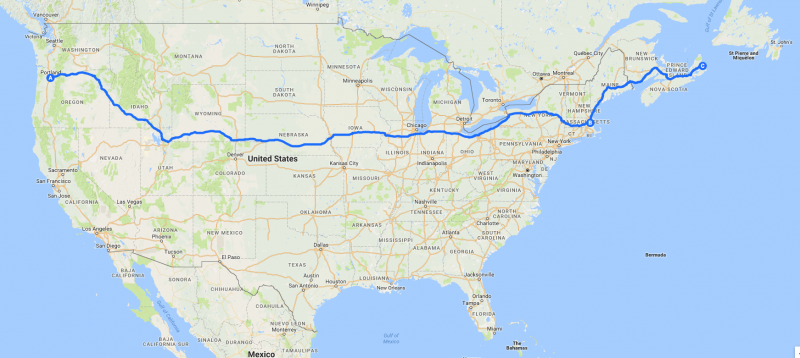
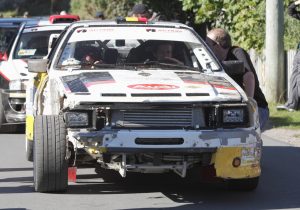
 What’s in store for 2017?
What’s in store for 2017?

